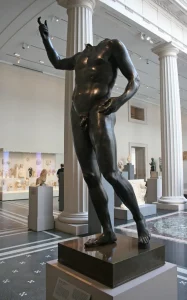Over the past month, my news feed has been bombarded with stories coming out of the Metropolitan Museum of Art in New York. Specifically, these stories are mainly about how investigators have found more and more antiquities in their collections that were originally looted or stolen.
A third-century headless bronze statue valued at $25 million has been in the Met’s collection for over a decade. Some speculate it was originally a statue of the Roman emperor Septimius Severus. Specialists now claim that the statue was stolen from an archaeological site in Bubon in southwestern Turkey. Bubon is the site of a Roman shrine that archaeologists say was dedicated to the Roman imperial cult, or the worship of the imperial family. Artifacts were discovered there by farmers in the 1960s, who subsequently sold the pieces rather than report the find to the relevant authorities as required by Turkish law. The Septimius Severus statue is owned by a Swiss collector who loaned it to the Met in 2011.
Over the past three months, the Manhattan District Attorney’s office confiscated eighteen items from the Met’s collection. The alleged Septimius Severus statue is one of several works that the DA’s office is repatriating to Turkey, including another bronze statue valued at $1.25 million showing the face of Septimius Severus’s son, the emperor Caracalla. The DA’s office is handing over twelve items valued at $33 million to Turkey’s consul-general in New York. But these were only the most recent antiquities to catch the authorities’ attention. Before authorities seized the Septimius Severus statue, the Met announced its plans to remove fifteen Indian sculptures from its collection. This was mainly because of their suspected connections to the disgraced Manhattan antiquities dealer Subhash Kapoor, who was arrested in 2011 and convicted in India just last year of burglary and illegal export. But while the Met removed these pieces from their collection without the DA having to come in and seize them, the museum administration was prompted to take action after the New York Supreme Court granted a warrant for their confiscation.
Though the museum administration is taking steps to address the gaps in the provenance of many of the antiquities in its collection, the Met still has some work to do. A recent report by the International Consortium of Investigative Journalists found that the Met’s collection contains “at least 1,109 pieces previously owned by people who had been either indicted or convicted of antiquities crimes.” This is mainly because the Met’s director between 1967 and 1977, Thomas Hoving, spearheaded a controversial approach that involved spending millions to acquire treasures from around the globe, paying little attention to where and how the previous owners came into their possession. So even though the Met has made some progress, it still has a long way to go. Despite its close relationship with the Manhattan DA’s office, the fact that the district attorney had to seize the Roman artifacts instead of the Met independently working to repatriate the pieces to Turkey might show that the museum might be dragging its feet a little in this matter. The Metropolitan Museum of Art is one of the most famous, most visited cultural institutions in the United States and the world, and much of the art world looks to the Met as an example to follow. But yet again, this research takes time. Even today, specialists have difficulty filling gaps in the provenance of certain pieces from decades or even centuries ago.

